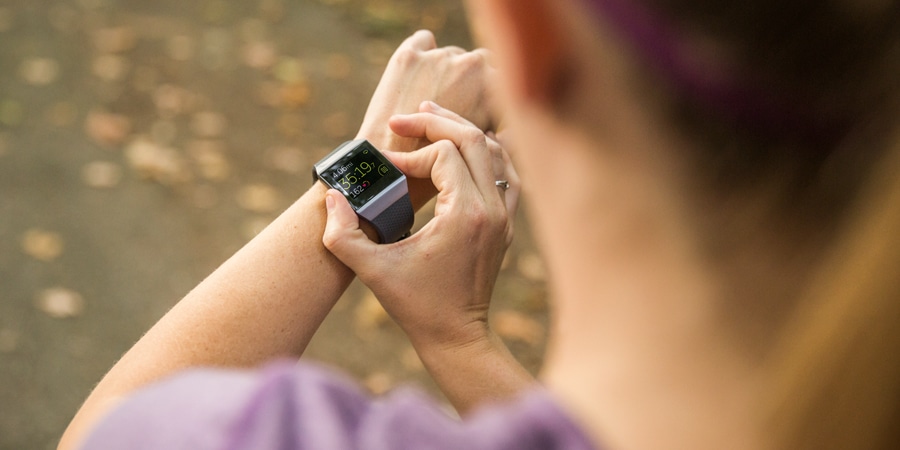Our love affair with technology has led legions of us to strap personal-training gadgets to our wrists. Because it's so powerful and versatile, though, figuring out how best to use a new fitness watch can be challenging. In this article, we'll discuss features that can help you become a better trail runner—and have more fun while you're at it. (We won't be offering step-by-step instructions for these features, though—for that, you'll need to spend quality time with your user's manual.)
If you haven't yet purchased a fitness watch, you can read How to Choose Fitness Electronics for buying tips. For trail running, getting a GPS Sports Watch is an excellent choice because it offers navigation capabilities.
A fitness watch can help trail runners in the following ways:
- Data tracking: Mileage, pace, elevation, heart rate and more; you can geek out to your heart's content and efficiently follow training plans.
- Navigation: Download new routes, stay on course, track back to the trailhead and more.
- Fun and motivation: Join communities, share data with friends, set up or join challenges, get badges for your accomplishments and more.
Getting Started with Your Fitness Watch

Your first step is to set up your software and apps. Every watch brand offers software and apps that let you manage, update, customize, sync and track data. That's where all of the community forums and fun stuff live, too. Spend some time exploring those tools to see which ones pique your interest.
If you don't use third-party fitness apps yet, this might also be a good time to get them. Strava is one of the most popular runner apps. Third-party apps have many of the same features your brand's app offers, but they also offer you access to an extended community and an extended library of user-provided running routes. A big library of routes to choose from is especially helpful whenever you visit a new area.
Data Tracking Features
Activity modes: Having a device that measures so many things can be a little paralyzing at first. That's why fitness watches include predefined activity modes. When you're starting out, simply put your watch into trail-running mode and it will select the most relevant data to track and display—things like distance, pace, elevation gain/loss, cadence and more. Press "start" when you hit the trail and "stop" when you return at the end of your run, and it can record and save all of the data from your run.
Heart rate data: Many watches offer heart rate monitoring, which is a valuable tool to track your fitness and workout intensity. Your watch might require a separate chest-strap accessory to do that, so be sure to get the strap and set it up if you want it to track heart rate data. For more details, read How to Train Using Heart Rate Zones.
Syncing with your phone: Many fitness watches give you the option of receiving phone alerts on your wrist. If you don't want to miss an important call or message while you're running, that's a handy feature to have and to set up. Syncing with your phone and other online devices after a run also makes it easy to download and pore over your accomplishments on the trail that day. Comparing your runs over time gives you a sense of accomplishment and an idea of how your fitness and running prowess are both improving.
Navigation Features

Watches offering GPS navigation offer a range of features to help you find your way. Three useful navigation functions for new users include the following:
Download routes: Before you can navigate, you need a route to follow. You can select and download routes from your watch software, third-party apps or routes that your friends send you. Then you can select that route before you begin your run.
Stay on course: Most watches won't have topographic-map detail, but they do display your trail and track your progress along it. If you make a wrong turn, the display will show that—and help guide you back to the main route.
Track back to start: If you choose to simply take off on a trail to see where it takes you, your watch can lay down a breadcrumb trail of waypoints. When you're ready to turn around, you simply follow that route back to the trailhead.
Community and Motivational Features

Connect and share: If you have family, friends or coworkers who use the same apps or software, you can share data, routes and more. You can also set up and join challenges. You can also join existing groups to learn from their members and participate in their activities. Most apps also offer sharing options with general social apps like Facebook and Instagram.
Earn badges: If you're not the competitive type, but you would enjoy a little motivational reward for your progress, then you can earn virtual badges for data milestones you pass. You can investigate them ahead of time to help you set goals, or wait and be happily surprised when one is bestowed upon you.
Follow training plans: If you're prepping for an event like your first 5K or 10K trail race, you can enter your training plan into your watch. You can do it manually or find training plans to download directly into your watch. You can also use training plans that others send to you.

